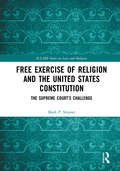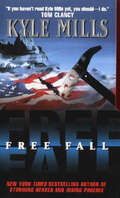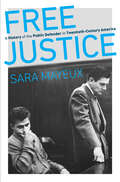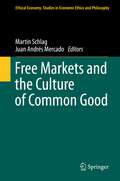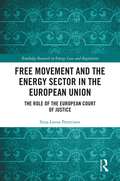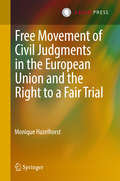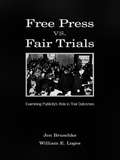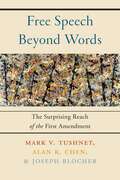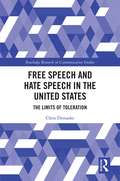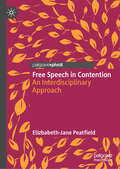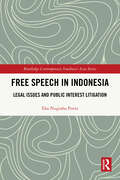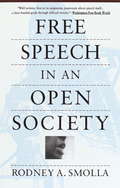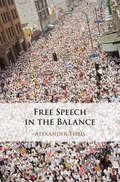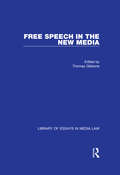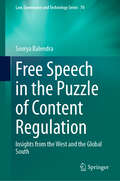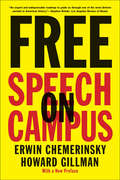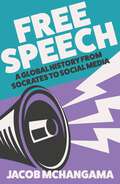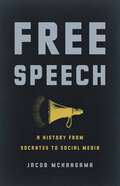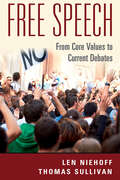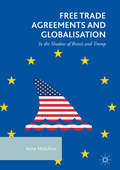- Table View
- List View
Free Culture: How Big Media Uses Technology and the Law to Lock Down Culture and Control Creativity
by Lawrence LessigDiscusses the ramifications of copyright law for culture. The author of this book donated a digital copy of this book. Join us in thanking Lawrence Lessig for providing his accessible digital book to this community.
Free Exercise of Religion and the United States Constitution: The Supreme Court’s Challenge (ICLARS Series on Law and Religion)
by Mark P. StrasserThe United States is extremely diverse religiously and, not infrequently, individuals sincerely contend that they are unable to act in accord with law as a matter of conscience. The First Amendment to the United States Constitution protects the free exercise of religion and the United States Supreme Court has issued many decisions exploring the depth and breadth of those protections. This book addresses the Court’s free exercise jurisprudence, discussing what counts as religion and the protections that have been afforded to a variety of religious practices. Regrettably, the Court has not offered a principled and consistent account of which religious practices are protected or even how to decide whether a particular practice is protected, which has resulted in similar cases being treated dissimilarly. Further, the Court’s free exercise jurisprudence has been used to provide guidance in interpreting federal statutory protections, which is making matters even more chaotic. This book attempts to clarify what the Court has said in the hopes that it will contribute to the development of a more consistent and principled jurisprudence that respects the rights of the religious and the non-religious.
Free Expression, Globalism and the New Strategic Communication
by Monroe E. PriceVast changes in technologies and geopolitics have produced a wholesale shift in the way states and other powerful entities think about the production and retention of popular loyalties. Strategic communication has embraced these changes as stakes increase and the techniques of information management become more pervasive. These shifts in strategic communications impact free speech as major players, in a global context, rhetorically embrace a world of transparency, all the while increasing surveillance and modes of control, turning altered media technologies and traditional media doctrines to their advantage. Building on examples drawn from the Arab Spring, the shaping of the Internet in China, Iran's perception of foreign broadcasting, and Russia's media interventions, this book exposes the anxieties of loss of control, on the one hand, and the missed opportunities for greater freedom, on the other. "New" strategic communication arises from the vast torrents of information that cross borders and uproot old forms of regulation. Not only states but also corporations, nongovernmental organizations, religious institutions, and others have become part of this new constellation of speakers and audiences.
Free Fall
by Kyle MillsFrom the #1 New York Times bestselling author of Vince Flynn's Mitch Rapp SeriesIt's bold. It's dangerous. It's the kind of maverick operation that has made Mark Beamon both the FBI's best agent and its least-likely-to-succeed screw-up.A top-secret FBI file -- buried in an anonymous government warehouse since J. Edgar Hoover's death -- is missing. The unlucky grad student who uncovered it is dead, and now his ex-girlfriend is on the run, accused of the murder. The only man everyone agrees can find the young woman and turn up the explosive document is "off-duty," suspended and under the threat of prosecution by the bureau itself.Beamon knows better than anyone that this is his last shot to save his career -- and his country. Tracking the young woman down, though, will be the hardest assignment he's ever tackled, for she's a gutsy world-class rock-climber who can drop out of sight anywhere in the world. And even if he finds her and the file, who can he trust when the FBI itself is under suspicion? Beamon has no room for wrong guesses -- or moves. If he blows this one, he'll free fall straight out of the bureau -- and straight into prison....
Free Justice: A History of the Public Defender in Twentieth-Century America (Justice, Power, and Politics)
by Sara MayeuxEvery day, in courtrooms around the United States, thousands of criminal defendants are represented by public defenders--lawyers provided by the government for those who cannot afford private counsel. Though often taken for granted, the modern American public defender has a surprisingly contentious history--one that offers insights not only about the "carceral state," but also about the contours and compromises of twentieth-century liberalism. First gaining appeal amidst the Progressive Era fervor for court reform, the public defender idea was swiftly quashed by elite corporate lawyers who believed the legal profession should remain independent from the state. Public defenders took hold in some localities but not yet as a nationwide standard. By the 1960s, views had shifted. Gideon v. Wainwright enshrined the right to counsel into law and the legal profession mobilized to expand the ranks of public defenders nationwide. Yet within a few years, lawyers had already diagnosed a "crisis" of underfunded, overworked defenders providing inadequate representation--a crisis that persists today. This book shows how these conditions, often attributed to recent fiscal emergencies, have deep roots, and it chronicles the intertwined histories of constitutional doctrine, big philanthropy, professional in-fighting, and Cold War culture that made public defenders ubiquitous but embattled figures in American courtrooms.
Free Market Environmentalism for the Next Generation
by Terry L. Anderson Donald R. LealThis book provides a vision for environmentalism's future, based on the success of environmental entrepreneurs around the world. The work provides the next generation of environmental market ideas and the chapters are co-authored with young scholars and policy analysts who represent the next generation of environmental leaders.
Free Markets and the Culture of Common Good
by Juan Andrés Mercado Martin SchlagRecent economic development and the financial and economic crisis require a change in our approach to business and finance. This book combines theology, economy and philosophy in order to examine in detail the idea that the functioning of a free market economy depends upon sound cultural and ethical foundations. The free market is a cultural achievement, not only an economic phenomenon subject to technical rules of trade and exchange. It is an achievement which lives by and depends upon the values and virtues shared by the majority of those who engage in economic activity. It is these values and virtues that we refer to as culture. Trust, credibility, loyalty, diligence, and entrepreneurship are the values inherent in commercial rules and law. But beyond law, there is also the need for ethical convictions and for global solidarity with developing countries. This book offers new ideas for future sustainable development and responds to an increasing need for a new sense of responsibility for the common good in societal institutions and good leadership.
Free Movement and the Energy Sector in the European Union: The Role of the European Court of Justice (Routledge Research in Energy Law and Regulation)
by Sirja-Leena PenttinenThis book analyses the case-law of the European Court of Justice on free movement in the energy sector. Sirja-Leena Penttinen provides a comprehensive review of the interpretation and application of the free movement provisions in the energy sector by the European Court of Justice (ECJ), which allow for cross-border energy trade (free movement of goods) and energy investments (free movement of capital). Through detailed analysis of ECJ case-law, Penttinen tracks the development of the legislative framework at EU level in response to the growth of the energy sector, as well as exposing the various political and economic nuances at play. In addition, she sheds light on the dynamic relationship between the EU Member States and their regulatory autonomy, the EU legislator, the Commission and the Court in the establishment of the EU internal energy market. Taking a coherent, systematic approach, this volume will be of great interest to scholars of EU law and energy policy, as well as policymakers and professionals working in this sector.
Free Movement of Civil Judgments in the European Union and the Right to a Fair Trial
by Monique HazelhorstThis book examines the attainment of complete free movement of civil judgments across EU member states from the perspective of its conformity with the fundamental right to a fair trial. In the integrated legal order of the European Union, it is essential that litigants can rely on a judgment no matter where in the EU it was delivered. Effective mechanisms for cross-border recognition and the enforcement of judgments provide both debtors and creditors with the security that their rights, including their right to a fair trial, will be protected. In recent years however, the attainment of complete free movement of civil judgments, through simplification or abolition of these mechanisms, became a priority for the European legislator. The text uniquely combines a thorough discussion of EU legislation with an in-depth and critical examination of its interplay with fundamental rights. It contains an overview and comparison of both ECtHR and CJEU case law on the right to a fair trial, and provides a great number of specific recommendations for current and future legislation. With its critical discussion of EU Regulations from both a practical and a theoretical standpoint, this book is particularly relevant to legislators and policymakers working in this field. Because of the extensive overview of the functioning of the EU's mechanisms and of relevant case law it provides the book is also highly relevant to academics and practitioners. Monique Hazelhorst is Judicial Assistant at the Supreme Court of the Netherlands. She studied Law and Legal Research at Utrecht University and holds a Ph. D. in Law from the Erasmus School of Law at Erasmus University Rotterdam.
Free Press Vs. Fair Trials: Examining Publicity's Role in Trial Outcomes (Routledge Communication Series)
by Jon Bruschke William Earl LogesCurrent research on media and the law has generally been atheoretical and contradictory. This volume explains why pretrial publicity is unlikely to affect the outcome of most jury trials, despite many experimental studies claiming to show the influence of publicity. It reviews existing literature on the topic and includes results from the authors' own research in an effort to answer four questions: *Does pretrial publicity bias the outcome of trials? *If it has an effect, under what conditions does this effect emerge? *What remedies should courts apply in situations where pretrial publicity may have an effect? *How does pretrial publicity relate to broader questions of justice? Reporting research based on actual trial outcomes rather than on artificial laboratory studies, Free Press vs. Fair Trials examines publicity in the context of the whole judicial system and media system. After a thorough review of research into pretrial publicity, the authors argue that the criminal justice system's remedies are likely to be effective in most cases and that there are much larger obstacles confronting defendants than publicity. This book presents the first extensive study of the influence of pretrial publicity on actual criminal trials, with results that challenge years of experimental research and call for more sophisticated study of the intersection of media and criminal justice. It is required reading for scholars in media law, media effects, legal communication, criminal justice, and related areas.
Free Speech Beyond Words: The Surprising Reach of the First Amendment
by Mark V. Tushnet Alan K. Chen Joseph BlocherA look at First Amendment coverage of music, non-representational art, and nonsenseThe Supreme Court has unanimously held that Jackson Pollock’s paintings, Arnold Schöenberg’s music, and Lewis Carroll’s poem “Jabberwocky” are “unquestionably shielded” by the First Amendment. Nonrepresentational art, instrumental music, and nonsense: all receive constitutional coverage under an amendment protecting “the freedom of speech,” even though none involves what we typically think of as speech—the use of words to convey meaning. As a legal matter, the Court’s conclusion is clearly correct, but its premises are murky, and they raise difficult questions about the possibilities and limitations of law and expression. Nonrepresentational art, instrumental music, and nonsense do not employ language in any traditional sense, and sometimes do not even involve the transmission of articulable ideas. How, then, can they be treated as “speech” for constitutional purposes? What does the difficulty of that question suggest for First Amendment law and theory? And can law resolve such inquiries without relying on aesthetics, ethics, and philosophy? Comprehensive and compelling, this book represents a sustained effort to account, constitutionally, for these modes of “speech.” While it is firmly centered in debates about First Amendment issues, it addresses them in a novel way, using subject matter that is uniquely well suited to the task, and whose constitutional salience has been under-explored. Drawing on existing legal doctrine, aesthetics, and analytical philosophy, three celebrated law scholars show us how and why speech beyond words should be fundamental to our understanding of the First Amendment.
Free Speech and Hate Speech in the United States: The Limits of Toleration (Routledge Research in Communication Studies)
by Chris DemaskeFree Speech and Hate Speech in the United States explores the concept and treatment of hate speech in light of escalating social tensions in the global twenty-first century, proposing a shift in emphasis from the negative protection of individual rights toward a more positive support of social equality. Drawing on Axel Honneth’s theory of recognition, the author develops a two-tiered framework for free speech analysis that will promote a strategy for combating hate speech. To illustrate how this framework might impact speech rights in the U.S., she looks specifically at hate speech in the context of symbolic speech, disparaging speech, internet speech and speech on college campuses. Entering into an ongoing debate about the role of speech in society, this book will be of key importance to First Amendment scholars, and to scholars and students of communication studies, media studies, media law, political science, feminist studies, American studies, and history.
Free Speech and Unfree News
by Sam LebovicDoes America have a free press? Many who say yes appeal to First Amendment protections against censorship. Sam Lebovic shows that free speech, on its own, is not sufficient to produce a free press and helps us understand the crises that beset the press amid media consolidation, a secretive national security state, and the daily newspaper's decline.
Free Speech in Contention: An Interdisciplinary Approach
by Elizbabeth-Jane PeatfieldThis short book examines the dynamic and complex nature of free speech, with reference to criminal law. It explores its historical roots, its role as a cornerstone of democracy, and its contemporary challenges. Free speech is not merely a legal right but a social and cultural tool that fosters democracy, innovation, and cultural progress. However, as society evolves, so too do the questions surrounding its boundaries and ethical implications. This book combines scholarly rigor with accessible writing and a measured approach to engage readers and students across disciplines and ideologies. It seeks to understand what free speech means and where its limits lie. By incorporating real-world examples, such as the debates around J.K. Rowling&’s comments on gender or the misinformation campaigns during the Brexit referendum, the book delves into the tension between free expression and the challenges of misinformation, hate speech, and cultural censorship. It addresses free speech not as an abstract principle but as a living, breathing mechanism shaping democracy, innovation, and cultural understanding. Its scope encompasses legal, ethical, political, and cultural dimensions, offering a comprehensive yet nuanced exploration of free speech&’s evolving landscape. The chapters lend themselves well to classroom reading and include recommendations at the end of each chapter.
Free Speech in Indonesia: Legal Issues and Public Interest Litigation (Routledge Contemporary Southeast Asia Series)
by Eka Nugraha PutraThis book discusses the practice of free speech and its limitations – defamation and hate speech – in the context of Indonesia.Focusing on several legislations, mainly in the Indonesian Criminal Code (KUHP) and the Information and Electronic Transaction Law (The ITE Law), the analysis centers on defamation and hate speech and how public interest defense is implemented in such limitations. The book discusses free speech in Indonesia through historical context and legal framework, both national and international. Detailed analyses of laws and case studies are provided, and the author examines key judicial decisions in defamation and hate speech cases that occurred in offline and online realms. The book demonstrates that Indonesia has ratified international human rights frameworks but that democracy in Indonesia has been declining in recent years, particularly due to the restrictions on free speech imposed by laws, which has resulted in a significant increase in cases involving free speech limitations.Offering a much-needed analysis of free speech and its implementation in Indonesia, this book will be of interest to academics studying Southeast Asia, Indonesia, Human Rights, Media Law, and Law in Asia.
Free Speech in an Open Society
by Rodney A. SmollaThis grand tour of First Amendment law underlines the intimate connection between free expression and democratic values as it leads us through the most treacherous and emotionally charged cases in American jurisprudence. “Intellectually venturesome. . . . ”—The New York Times Book Review
Free Speech in the Balance
by Alexander TsesisFree Speech in the Balance is the first comprehensive study of proportional analysis in free speech theory. This book challenges the US Supreme Court's categorical approach and explains the importance of understanding the breadth of concerns arising from regulations directly and indirectly impacting expression. The author provides in-depth analysis of some of the important social and political principles governing topics of vital concern, including campaign financing, university speech codes, secondary school rules, incitement, and threats. This book should be read by students and scholars of free speech theory and anyone interested in learning more about the history of existing law, the issues of current importance, and trends in expressive significance.
Free Speech in the New Media (Library of Essays in Media Law)
by Thomas GibbonsThis volume deals with questions of political and constitutional principle and theory that affect the law and regulation of content in new media that are based on digital technology. In the light of convergence between different forms of communication, it examines whether the justifications for government intervention in traditional analogue broadcasting and programme delivery continue to be persuasive. The essays examine in general whether new approaches to freedom of expression are required in the digital era and whether there is a continued role for public service broadcasting or its equivalent. They also explore content standards in more detail, discussing arguments for and against regulation in the areas of beliefs, indecency and advertising and whether there is a case for the European Union's measures to secure "Television without Frontiers".
Free Speech in the Puzzle of Content Regulation: Insights from the West and the Global South (Law, Governance and Technology Series #20)
by Soorya BalendraThis book explores the intersection of law and technology, focusing on online speech regulations and their complex interplay with free speech in the digital age. It identifies three primary regulatory models – self-regulation, external regulation, and co-regulation – and examines how each model presents recurring challenges in both content moderation and the protection of free speech. The study delves into the regulation of harmful speech, including defamation, violence, misinformation, and propaganda, highlighting the tensions between regulating prohibited content and preserving free speech online. Additionally, the book addresses digital authoritarianism and its manifestation in regulatory approaches, particularly the Chinese model of content regulation. It also scrutinizes platform-driven regulation, assessing the challenges posed by both human and AI-driven content moderation. Through a comparative analysis of legal frameworks across key jurisdictions – including the United States (Section 230 of the Communications Decency Act), Germany (the Network Enforcement Act), India (the Information Technology (Intermediary Guidelines and Digital Media Ethics Code) Rules, 2021), and Sri Lanka (the Online Safety Act, 2024) – the book examines how these frameworks navigate the balance between free speech rights and platform responsibilities, in these jurisdictions with the distinct context, power asymmetry of authorities with the platforms, political and cultural landscape, and social media market. It further explores how these evolving models reflect significant differences in the roles of governments, platforms, regulatory authorities, standards, and compliance mechanisms. By engaging in a scholarly discussion on these issues from a legal and regulatory perspective, this book seeks to strike a balance between online free speech and legitimate restrictions. It provides a comparative lens on Western jurisprudence and the Majority World, linking common themes across jurisdictions to shed light on the intricate challenges of regulating online speech. In doing so, the book addresses a gap in the existing literature, offering a much-needed foundation for developing and updating both internal and external regulatory frameworks.
Free Speech on Campus
by Erwin Chemerinsky Howard GillmanCan free speech coexist with an inclusive campus environment? Hardly a week goes by without another controversy over free speech on college campuses. On one side, there are increased demands to censor hateful, disrespectful, and bullying expression and to ensure an inclusive and nondiscriminatory learning environment. On the other side are traditional free speech advocates who charge that recent demands for censorship coddle students and threaten free inquiry. In this clear and carefully reasoned book, a university chancellor and a law school dean—both constitutional scholars who teach a course in free speech to undergraduates—argue that campuses must provide supportive learning environments for an increasingly diverse student body but can never restrict the expression of ideas. This book provides the background necessary to understanding the importance of free speech on campus and offers clear prescriptions for what colleges can and can’t do when dealing with free speech controversies.
Free Speech: A Global History from Socrates to Social Media
by Jacob MchangamaA global history of free speech, from the ancient world to today.Hailed as the "first freedom," free speech is the bedrock of democracy. But it is a challenging principle, subject to erosion in times of upheaval. Today, in democracies and authoritarian states around the world, it is on the retreat.In Free Speech, Jacob Mchangama traces the riveting legal, political, and cultural history of this idea. Through captivating stories of free speech's many defenders - from the ancient Athenian orator Demosthenes and the ninth-century freethinker al-Razi, to Mary Wollstonecraft, Mahatma Gandhi, Nelson Mandela and modern-day digital activists - Mchangama demonstrates how the free exchange of ideas underlies all intellectual achievement and has enabled the advancement of both freedom and equality worldwide. Yet the desire to restrict speech is also a constant, and he explores how even its champions can be led down this path when the rise of new and contrarian voices challenge power and privilege of all kinds.Meticulously researched, deeply humane and provocative, Free Speech challenges us all to recognise how much we have gained from this principle - and how much we stand to lose without it.
Free Speech: A Global History from Socrates to Social Media
by Jacob MchangamaA global history of free speech, from the ancient world to today.Hailed as the "first freedom," free speech is the bedrock of democracy. But it is a challenging principle, subject to erosion in times of upheaval. Today, in democracies and authoritarian states around the world, it is on the retreat.In Free Speech, Jacob Mchangama traces the riveting legal, political, and cultural history of this idea. Through captivating stories of free speech's many defenders - from the ancient Athenian orator Demosthenes and the ninth-century freethinker al-Razi, to Mary Wollstonecraft, Mahatma Gandhi, Nelson Mandela and modern-day digital activists - Mchangama demonstrates how the free exchange of ideas underlies all intellectual achievement and has enabled the advancement of both freedom and equality worldwide. Yet the desire to restrict speech is also a constant, and he explores how even its champions can be led down this path when the rise of new and contrarian voices challenge power and privilege of all kinds.Meticulously researched, deeply humane and provocative, Free Speech challenges us all to recognise how much we have gained from this principle - and how much we stand to lose without it.(P) 2022 Hodder & Stoughton Limited
Free Speech: A History from Socrates to Social Media
by Jacob Mchangama&“The best history of free speech ever written and the best defense of free speech ever made.&” —P.J. O&’RourkeHailed as the &“first freedom,&” free speech is the bedrock of democracy. But it is a challenging principle, subject to erosion in times of upheaval. Today, in democracies and authoritarian states around the world, it is on the retreat.In Free Speech, Jacob Mchangama traces the riveting legal, political, and cultural history of this idea. Through captivating stories of free speech&’s many defenders—from the ancient Athenian orator Demosthenes and the ninth-century freethinker al-Rāzī, to the anti-lynching crusader Ida B. Wells and modern-day digital activists—Mchangama reveals how the free exchange of ideas underlies all intellectual achievement and has enabled the advancement of both freedom and equality worldwide. Yet the desire to restrict speech, too, is a constant, and he explores how even its champions can be led down this path when the rise of new and contrarian voices challenge power and privilege of all stripes.Meticulously researched and deeply humane, Free Speech demonstrates how much we have gained from this principle—and how much we stand to lose without it.
Free Speech: From Core Values to Current Debates
by Thomas Sullivan Len NiehoffWhy do we protect free speech? What values does it serve? How has the Supreme Court interpreted the First Amendment? What has the Court gotten right and wrong? Why are current debates over free expression often so divisive? How can we do better? In this succinct but comprehensive and scholarly book, authors Len Niehoff and Thomas Sullivan tackle these pressing questions. Free Speech: From Core Values to Current Debates traces the development and evolution of the free speech doctrine in the Supreme Court and explores how the Court - with varying levels of success - has applied that doctrinal framework to “hard cases” and current controversies, such as those involving hate speech, speech on the internet, speech on campus, and campaign finance regulation. This is the perfect volume for anyone - student, general reader, or scholar - looking for an accessible overview of this critical topic.
Free Trade Agreements and Globalisation: In the Shadow of Brexit and Trump
by Arne MelchiorThis book analyses the fast spread of free trade agreements (FTAs) across the globe, their content and their economic impact. In the wake of Brexit and the new protectionism of President Trump, Melchior offers a timely assessment of key issues relating to FTAs.Dividing the world into seven major regions, he analyses world trade, the globalisation of FTAs and their role within and between the regions. Using a new world trade model, he then presents new evidence on the impact of trade agreements, the value of trade, the impact of China’s growth and the West’s industrial decline, and the role of reciprocity in trade policy. Covering rich and poor countries, commodity exporters and all of the world’s regions, he offers new and original insights about a number of pertinent issues facing today’s world.

